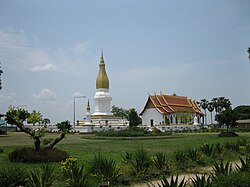| That Sikhottabong | |
|---|---|
 That Sikhottabong of Thakhek | |
| Religion | |
| Affiliation | Buddhism |
| Location | |
| Location | Thakhek, Khammouane Province, Laos |
| Country | Laos |
| Geographic coordinates | 17°26′10″N104°44′26″E / 17.4359819°N 104.7404971°E |
| Architecture | |
| Founder | King Nanthasene |
That Sikhottabong, also known as Sikhottabong Stupa is a Buddhist temple in Thakhek, Khammouane Province, Laos. It is contemporary to That Inhang in Savannakhet and That Phanom, built in Thailand under the Sikhottabong Kingdom. The bones of Buddha are said to be consecrated in these temples. King Nanthasene built the stupa for King Soummitham.
Contents
The temple is on the bank of the Mekong River. The festival held at this location is during the third month of the lunar calendar. [1]


